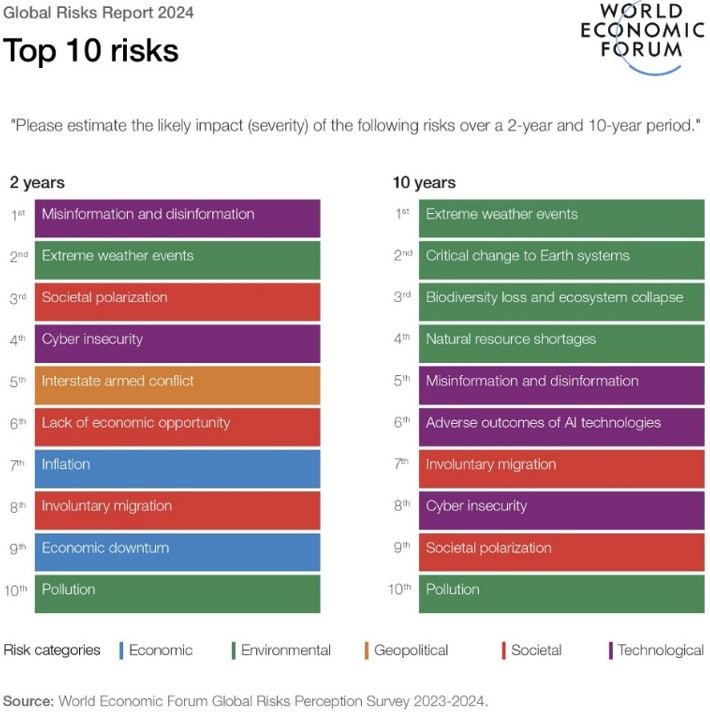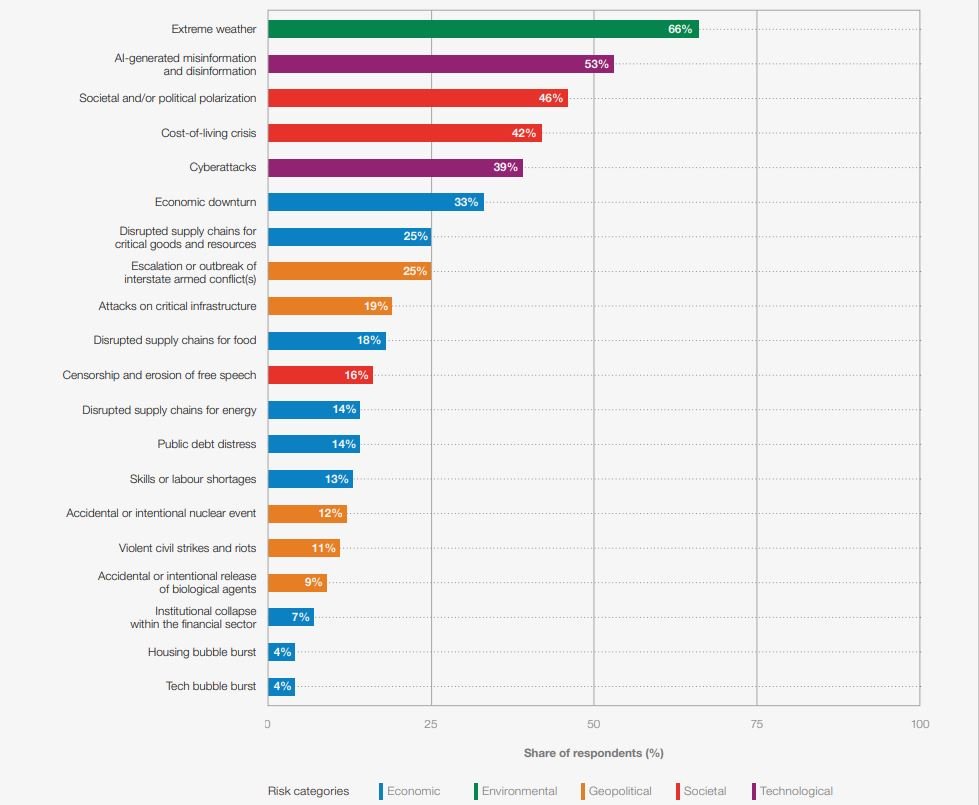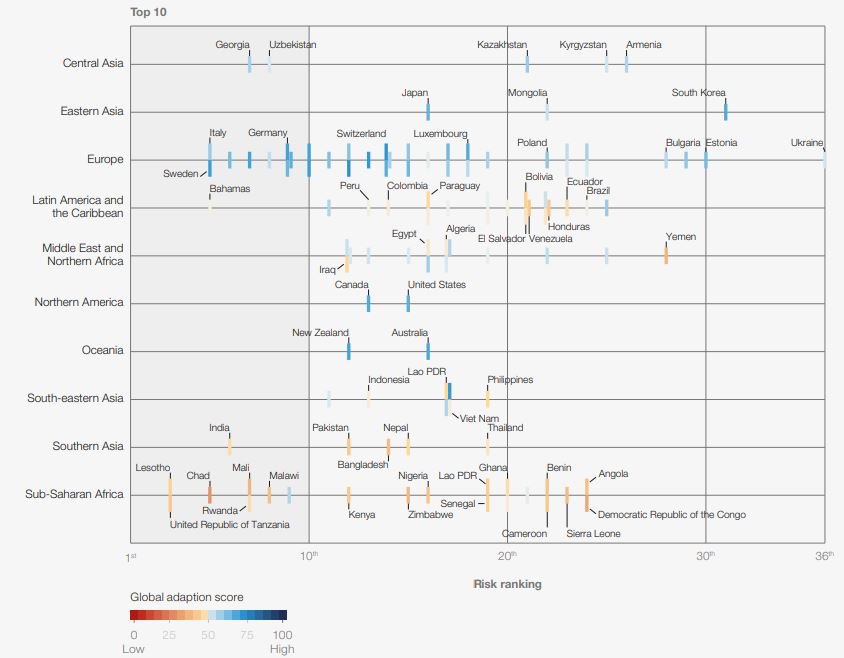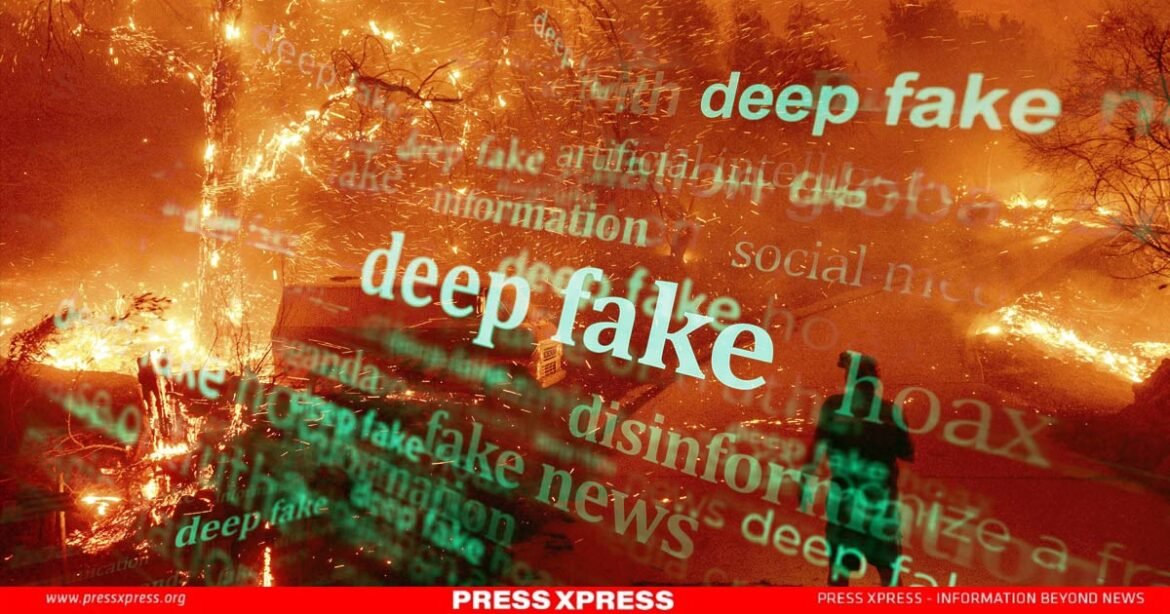Key Highlights:
- The report highlights the need for dialogue in the face of growing global fractures.
- The risks are growing — but so is our capacity to respond
- Nearly 17 percent of land in Bangladesh could be submerged by the rising sea level by 2050
- 1,915 major rumors circulated in Bangladesh throughout 2023
On January 10, the Global Risks Report 2024 by the World Economic Forum highlights the significant challenges facing the world. The report identifies artificial intelligence-driven misinformation and disinformation as the most pressing global risk in the next two years, with long-term concerns centered around extreme weather and critical changes to earth systems.
Drawing from a survey of nearly 1,500 global risk experts, policymakers, and business leaders, the report identifies the potential scarcity of cooperation on urgent global issues. This scarcity, it suggests, necessitates innovative approaches to address emerging risks. Key concerns for 2024 include a persistent cost-of-living crisis, the risks associated with AI-driven misinformation and disinformation, and escalating societal polarization.
Against the backdrop of rapid technological advancements, economic uncertainty, a warming planet, and ongoing conflicts, the Global Risks Report delves into some of the most severe challenges that the world may encounter over the next decade. As global cooperation faces strain, weakened economies and societies may be susceptible to tipping points with even minor shocks. The 19th edition of the report, set against the context of accelerated technological change and economic uncertainty, portrays a world grappling with two intertwined crises: climate and conflict. Last year’s report had already warned of a world struggling to recover from persistent shocks, and as 2024 unfolds, these challenges persist and intensify.

Misinformation threat in huge election year
According to the American Psychological Association, misinformation is defined as “false or inaccurate information — getting the facts wrong,” while disinformation refers to “false information which is deliberately intended to mislead.” In a notable shift for the survey, which spans almost two decades, experts have identified misinformation and disinformation as the most severe risk in the coming two years. This coincides with a remarkable year for global elections, expecting nearly 3 billion people to participate in the polls in 2024.
The advent of artificial intelligence (AI) has significantly facilitated the dissemination of false information to influence voters, including the use of deepfakes, as noted by Carolina Klint, one of the authors of the report and the Chief Commercial Officer for Europe at Marsh McLennan, a professional services firm.
For the first time in a decade, cyber insecurity has entered the top five short-term risks, ranking fourth, following societal polarization and preceding interstate armed conflict. Klint emphasized that AI has heightened the immediacy of the cyber threat, enabling cybercriminals to execute complex tasks like coding. She pointed out that a “malicious actor doesn’t have to be that smart,” broadening the opportunities for cybercriminals and accelerating cyber attacks. Despite these challenges, Klint acknowledged the potential for AI to play a positive role in detecting malicious activities.
Extreme weather
The preceding year has entered the annals as the hottest on record globally, as per the European Union’s Copernicus Climate Change Service (C3S), potentially marking the warmest period in the past 100,000 years. This unsettling reality is linked to extreme weather events, now ranked as the second short-term risk, underscoring a growing awareness of environmental and climate change issues amid escalating temperatures, floods, and wildfires.
The Earth confronts the peril of abrupt, irreversible shifts in its systems, leading to more frequent extreme weather events and potential ecosystem collapses ill-prepared for new climates. The primary remedy involves swift emissions reduction and collaborative efforts among economic stakeholders to expedite a transition to cleaner practices, crucial for averting or delaying critical changes to Earth systems.
Rapidly curbing human emissions stands as a pivotal lever to postpone or prevent these critical shifts. Once a climate tipping point is crossed, natural systems amplify changes, emphasizing the urgency to defer such tipping points to allow society time to devise suitable adaptation and resilience strategies.
Addressing systemic collapse from environmental risks necessitates a second priority: effective adaptation to impending changes. As sea levels rise, a holistic ecosystem of interconnected solutions becomes vital to counter threats to human life, landscapes, and property. Existing solutions, such as innovative practices from African farmers adept at managing droughts and floods, hold significance for improving European crop quality. Similarly, grassroots innovations in relocating Arctic communities, acting as early indicators of climate disaster, offer valuable insights into policy safeguards and effective approaches for managing forced migration resulting from sea-level rise.

Source: World Economic Forum Global Risks Perception Survey 2023-2024.
Recession concerns
Saadia Zahidi, the Managing Director of the World Economic Forum (WEF), conveyed a more pessimistic long-term outlook in the latest survey, citing “economic hardship” as a prominent concern. Despite potential containment of inflation, Zahidi noted persistently elevated prices compared to the past couple of years. Short-term risks, ranking sixth, seventh, and ninth, include a lack of economic opportunity, persistently high inflation, and an economic downturn. Zahidi underscored the deepening inequality, contributing to a decline in living standards for certain individuals. She cautioned against viewing the survey as a crystal ball, emphasizing the role of decision-makers in shaping outcomes.
John Scott, Head of Sustainability Risk at Zurich Insurance Group, a collaborator on the report, emphasized the need for collective action to address these challenges. The survey, determining the top 10 risks over both short and long terms, assessed the likely impact of 34 global risks, providing insights into rankings based on respondents’ severity assessments. Participants also had the option to add any additional risks not included in the predefined list.

High risk for Bangladesh
During the 2024 national Parliamentary election in Bangladesh, a significant surge of misinformation and disinformation was observed, disseminated by both national and international entities. Rumor Scanner, a fact-checking platform operating on Facebook and YouTube, disclosed that at least 56 rumors about Prime Minister Sheikh Hasina had proliferated online, primarily on YouTube, in the last three months (October-December).
The second-highest number of rumors targeted various state agencies. Among them were 24 rumors about the police, 18 regarding Chief Election Commissioner Kazi Habibul Awal, and 17 concerning diplomatic and various local and international organizations. Of the total political rumors in the last three months of 2023, an astounding 83.7% were associated with the general election.
Furthermore, Bangladesh confronts substantial challenges as one of the primary victims of climate change. Projections suggest that nearly 17 percent of the country’s land could be submerged by the rising sea level by 2050. Consequently, an estimated 20 million people in Bangladesh may lose their homes due to the encroaching sea level. Globally, rising sea levels could displace at least 1.2 billion people by the year 2050.
According to the Global Climate Risk Index 2021, Bangladesh is the seventh most at-risk country for disasters in the world. Climate change exacerbates living conditions for people residing near the coast, in the north, and by rivers, making these areas susceptible to cyclones, saline intrusion, droughts, floods, and riverbank erosion. Consequently, many individuals are compelled to abandon their homes. The World Health Organization reports that in 2022, more than 7.1 million Bangladeshis had to relocate due to climate change.
The climate crisis in Bangladesh is causing a substantial number of people to lose their homes and jobs, prompting a migration to major cities like Dhaka, Chattogram, Khulna, and Rajshahi. In 2014, a census of slum areas revealed that over 2.2 million people lived in impoverished neighborhoods nationwide. However, presently, Dhaka alone accommodates a staggering 10 million people who have had to vacate their homes, with an additional 2,000 individuals joining the city every day.

The government’s initiative to reduce the climate risk
Bangladesh’s government took several steps to deal with people having to leave their homes because of climate change. The government moved these people to new villages on public lands. The Ashrayan project, a special plan for those without homes or land, gave over 0.4 million families new houses. Also, Bangladesh started the world’s biggest project to provide homes for 4,409 families who had to leave because of climate issues. These families also got training in important skills like leadership, getting ready for disasters, and making money.
To help people who had to leave because of climate change, the government linked the efforts with local projects to fight climate change and reduce poverty. This involved teamwork between the main government, its seventeen parts, and local councils under the social safety program. Another goal was to increase funds by seeking more help from donors and creating a separate system to manage the money.
The Benefits of The Ashrayan Project
A thorough examination of the Ashrayan model has revealed that the project beneficiaries have seen a significant.
| Benefits | Socio-economic Changes in Percentage |
| Sense of security | 98.87 |
| Improvement of social status | 98.50 |
| Rise of living standard | 95.20 |
| Ability to purchase new furniture | 70.22 |
| Boost in positive behavior | 60.78 |
| Growth in social harmony | 60.21 |
| Capacity to acquire electronic devices | 56.78 |
| Engagement in cultural activities | 35.50 |
Government Initiative to Lessen Disinformation
Prior to the election in Bangladesh, the Bangladesh Telecommunication Regulatory Commission (BTRC) held separate meetings with Facebook, TikTok, and Google authorities in August and September 2023, instructing them to take necessary measures for the January 7 polls.
Following the instructions, TikTok created a ‘Bangladesh Election Centre’ to deliver accurate election information for Bangladeshis only. TikTok stated that its community guidelines include specific policies to control the spread of false information, violence, and hate speech directly during elections. The policies cover eligibility of candidates, voter registrations, counting of ballots, election results, and many other issues. The platform promptly removed misleading election-related information based on these norms.
According to the BTRC, the current number of internet users in the country is around 13 crores, with more than 50 million people using Facebook.
On November 28, former Information Minister Hasan Mahmud stated that spreading rumors through digital media would be dealt with under the [Cyber Security Act].
In January 2023, the minister ordered deputy commissioners to stay on guard against anyone spreading “rumors” through unregistered online portals, IPTV, or YouTube channels.


